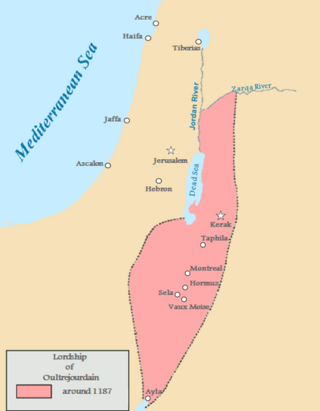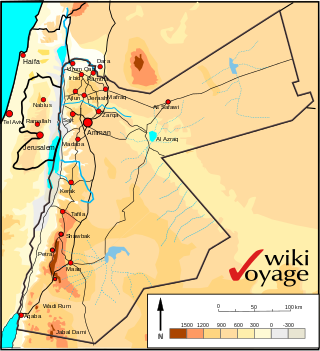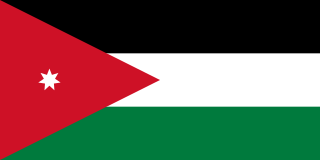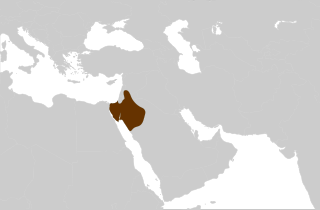
Ammon was an ancient Semitic-speaking kingdom occupying the east of the Jordan River, between the torrent valleys of Arnon and Jabbok, in present-day Jordan. The chief city of the country was Rabbah or Rabbat Ammon, site of the modern city of Amman, Jordan's capital. Milcom and Molech are named in the Hebrew Bible as the gods of Ammon. The people of this kingdom are called Children of Ammon or Ammonites.

The Kingdom of Israel, or the Kingdom of Samaria, was an Israelite kingdom in the Southern Levant during the Iron Age, whose beginnings can be dated back to the first half of the 10th century BCE. The kingdom controlled the areas of Samaria, Galilee and parts of Transjordan. The regions of Samaria and Galilee underwent a period with large number of settlements during the 10th century BCE, with the capital in Shechem, and then in Tirzah. The kingdom was ruled by the Omride dynasty in the 9th century BCE, whose political center was the city of Samaria.

The history of Jordan refers to the history of the Hashemite Kingdom of Jordan and the background period of the Emirate of Transjordan under British protectorate as well as the general history of the region of Transjordan.

Moab is an ancient Levantine kingdom whose territory is today located in southern Jordan. The land is mountainous and lies alongside much of the eastern shore of the Dead Sea. The existence of the Kingdom of Moab is attested to by numerous archaeological findings, most notably the Mesha Stele, which describes the Moabite victory over an unnamed son of King Omri of Israel, an episode also noted in 2 Kings 3. The Moabite capital was Dibon. According to the Hebrew Bible, Moab was often in conflict with its Israelite neighbours to the west.

Al-Karak is a city in Jordan known for its medieval castle, the Kerak Castle. The castle is one of the three largest castles in the region, the other two being in Syria. Al-Karak is the capital city of the Karak Governorate.

Aqaba is the only coastal city in Jordan and the largest and most populous city on the Gulf of Aqaba. Situated in southernmost Jordan, Aqaba is the administrative center of the Aqaba Governorate. The city had a population of 148,398 in 2015 and a land area of 375 square kilometres (144.8 sq mi). Today, Aqaba plays a major role in the development of the Jordanian economy, through the vibrant trade and tourism sectors. The Port of Aqaba also serves other countries in the region.

Heshbon were at least two different ancient towns located east of the Jordan River in what is now the Kingdom of Jordan, historically within the territories of ancient Ammon.

Montreal, or Qal'at ash-Shawbak in Arabic, is a castle built by the Crusaders and expanded by the Mamluks, on the eastern side of the Arabah Valley, perched on the side of a rocky, conical mountain, looking out over fruit orchards below. The ruins are located next to the modern town of Shoubak in Jordan.

The Lordship of Oultrejordain or Oultrejourdain was the name used during the Crusades for an extensive and partly undefined region to the east of the Jordan River, an area known in ancient times as Edom and Moab. It was also referred to as Transjordan.

Mount Seir is the ancient and biblical name for a mountainous region stretching between the Dead Sea and the Gulf of Aqaba in the northwestern region of Edom and southeast of the Kingdom of Judah. It may also have marked the older historical limit of Ancient Egypt in Canaan. A place called "Seir, in the land of Shasu", thought to be near Petra, Jordan, is listed in the temple of Amenhotep III at Soleb.

Dhiban, known to the Moabites as Dibon, is a Jordanian town located in Madaba Governorate, approximately 70 kilometres south of Amman and east of the Dead Sea. Previously nomadic, the modern community settled the town in the 1950s. Dhiban's current population is about 15,000, with many working in the army, government agencies, or in seasonal agricultural production. A number of young people study in nearby universities in Karak, Madaba, and Amman. Most inhabitants practice Islam.

Tafilah is one of the governorates of Jordan, located about 180 km south-west of Amman, Jordan's capital.

Jordan, officially the Hashemite Kingdom of Jordan, is a country in the Levant region of West Asia. Jordan is bordered by Syria to the north, Iraq to the east, Saudi Arabia to the south, and the Palestinian West Bank and Israel to the west. The Jordan River, flowing into the Dead Sea, is located along the country's western border, while Jordan has a small coastline along the Red Sea in its southwest, separated by the Gulf of Aqaba from Egypt. Amman is Jordan's capital and largest city, as well as the most populous city in the Levant.

The Battle of Belvoir Castle, also called the Battle of Le Forbelet, was a part of Saladin’s campaign in May — August 1182 against the Crusaders. Crusader forces led by King Baldwin IV of Jerusalem battled with Ayyubid forces from Egypt commanded by Saladin. The Crusaders successfully won and repelled Saladin's invasion effort. The theatre of operations included Ayla, Transjordan, Galilee and Beirut.

The Nabataean Kingdom, also named Nabatea, was a political state of the Nabataeans during classical antiquity.

Edom was an ancient kingdom in Transjordan, located between Moab to the northeast, the Arabah to the west, and the Arabian Desert to the south and east. Most of its former territory is now divided between present-day southern Jordan and Israel. Edom appears in written sources relating to the late Bronze Age and to the Iron Age in the Levant.

The Qedarites were a largely nomadic ancient Arab tribal confederation centred in their capital Dumat al-jandal in the Al-Jawf Province. Attested from the 9th century BC, the Qedarites formed a powerful polity which expanded its territory over the course of the 9th to 7th centuries BC to cover a large area in northern Arabia stretching from Transjordan in the west to the western borders of Babylonia in the east, before later moving westwards during the 6th to 5th centuries BC to consolidate into a kingdom stretching from the eastern limits of the Nile Delta in the west till Transjordan in the east and covering much of southern Judea, the Negev and the Sinai Peninsula.
The Assyrian conquest of Aram concerns the series of conquests of largely Aramean, Phoenician, Sutean and Neo-Hittite states in the Levant by the Neo-Assyrian Empire. This region was known as Eber-Nari and Aram during the Middle Assyrian Empire and the Neo-Assyrian Empire.
Transjordan, the East Bank, or the Transjordanian Highlands, is the part of the Southern Levant east of the Jordan River, mostly contained in present-day Jordan.

Ash-Sharāt or Ash-Sharāh (Arabic: ٱلشَّرَاة, also known as Bilād ash-Sharāt or Jibāl ash-Sharāt, is a highland region in modern-day southern Jordan and northwestern Saudi Arabia. It was formerly a sub-district in Bilad al-Sham during the 7th–11th centuries CE.















